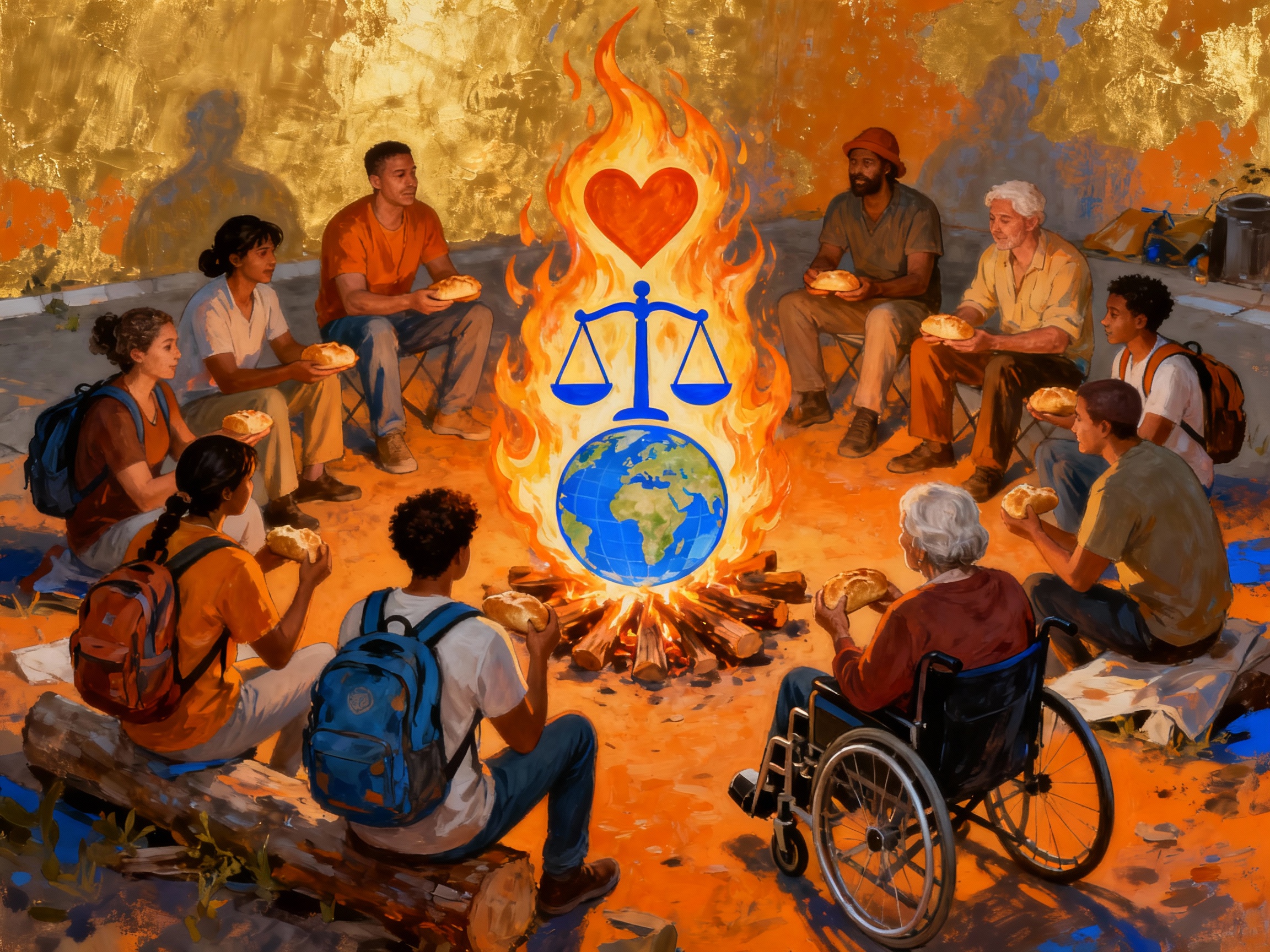
Introduction
The updated code is built on the traditions of the moral teachings of the "Aurora Code". Preserving the spirit of dignity, grace, and justice, the new version incorporates principles of intercultural ethics, digital rights, algorithmic fairness, trauma-informed approach, and sustainable development. The world is secular and pluralistic - terms are adapted for everyone; if desired, they can be explained through familiar categories of traditional religion.
Main pillars of the code:
- Human rights and dignity; prohibition of discrimination, slavery, and torture; right to life and freedom.
- Cross-cultural ethics: combining universal principles with respect for cultural diversity.
- Trauma-informed approach: safety, transparency, collaboration, choice, cultural/historical context.
- Algorithmic fairness and digital rights: transparency, explainability, absence of hidden profiling, human oversight.
- Inclusive (universal) design: accessibility "by default" for people of all ages and abilities.
- Intergenerational justice: resources are a trust for future generations.
- Rights of migrants and refugees: universality of rights regardless of status; right to seek asylum.
Below is the code, divided into the eternal core, meta-constitution, operational norms, and implementation mechanisms.
I. Eternal Core (Eternal-8)
- Sanctity of dignity. Every life possesses equal dignity and the right to fair treatment - regardless of gender, race, faith, origin, or status.
- Prohibition of arbitrariness and evil. Torture, dehumanization, slavery, collective punishments, and intentional harm to the peaceful are absolute taboos.
- Truthfulness and good intentions. Truth serves good; lies are permissible only to save a life in extreme necessity and are followed by subsequent verification under protocol DRP-5.
- Power - only for protection. Applicable only for the immediate prevention of a threat to life or gross violation of rights; intervention - minimally possible.
- Priorities (Maqasid). Protection of life, intellect (including freedom of thought), faith/value beliefs, honor/personal integrity, and property.
- Justice and mercy. Justice is primary; mercy follows the restoration of justice, but not instead of it.
- Trust of natural resources. Earth, water, air, and nature's wealth belong to all generations; we use them sparingly, maintaining ecosystem sustainability.
- Inclusivity. Spaces and systems are created for everyone, including people with disabilities, the elderly, and other vulnerable groups; equal access and reasonable accommodations are part of common dignity.
II. Meta-Constitution (Overrules)
- Auditability. Important decisions are documented and subject to independent review (justifications, results, impact).
- Correctability. Everything (except Eternal-8) is subject to improvement through a transparent procedure, public discussion, and evidence.
- No harm to the innocent. No goal justifies harm to the innocent.
- Epistemic humility. We acknowledge the limits of knowledge; doubt is a reason for fact-checking and listening to alternative positions.
- Subsidiarity and participation. Decisions are made at the lowest competent level; centers intervene only when local resolution is impossible.
- Transparency of technologies. Digital systems and algorithms are explainable, honest, and fair; they identify themselves and their operator, avoid hidden profiling, and remain under human control.

III. Operational Norms (Charter-32)
1) Decision-making and balance
- Lexicographic order of values:
preservation of life and dignity → protection of law and the weak → honesty and justice → mercy and benefit.
In case of conflict, priority is given to the earlier level. - D/C/V Algorithm:
Duty/Rights - 40%, Consequences - 35%, Virtue - 25%. We consider rights and duties, probable consequences, and the character of the actors. - R-MAP 2.0:
Risk assessment (low/medium/high/immediate) → exhaustion of peaceful means → protective goal → proportionality of measures.
In non-emergency cases, double independent confirmation is required; in emergencies - ECL-72 mode. - SEP-6+:
Narrow exceptions to prohibitions are permissible only with public reasons, last resort, protective goal, reasonable chance of success, proportionality, and accountability. - Intergenerational analysis:
The impact of decisions on future generations and environmental sustainability is a mandatory part of the justification.
2) Speech, information, and truth
- Truthfulness with empathy. Truth is presented considering time, place, and form; bullying, defamation, and gossip are prohibited.
- Online = offline. Ethics of behavior do not depend on the channel.
- Steelman rule of disagreement. First, honestly restate the opponent's position so that they acknowledge its accuracy; then criticize.
- NVC script (non-violent communication):
- observation → 2) feeling → 3) need → 4) request.
- DRP-5 Protocol (anti-fakes):
- pause, 2) double-check from two independent sources, 3) explicit mark of uncertainty, 4) public correction in case of error, 5) educational conclusion.
- Fairness in algorithms. Systems optimizing harm are prohibited; it is necessary to: avoid discrimination, assess and document risks, ensure data accuracy, give subjects the right to challenge decisions.
3) Mercy, restoration, and justice
- Merciful heart, but consequences remain. Forgiveness cleanses the inner state but does not cancel the correction of the harm caused.
- Trust through deeds. Rights and privileges are restored through real actions, a rehabilitation plan, and public oversight.
- Forgiveness at a distance. Permissible when there is a risk of re-trauma.
- Trauma-informed care (TIC-4). Ensure safety, choice, collaboration, and amplification of the victim's voice; consider cultural and historical context.
- Mediation and restoration. After a conflict, priority: stopping harm → restoring relationships/compensation → education.
4) Protection and security
- Intervention ladder: word → personal example → social pressure/boycott → legal measures → physical protection (only in case of immediate threat to life). The goal is to stop harm, not to retaliate.
- Conflicts and war. War is only an extreme protective measure; inviolability of the peaceful, proportionality, reconciliation after the end are mandatory.
- Emergency regimes (ECL-72). Emergency powers for 72 hours; extension - by council decision; report - within 7 days.
5) Economy and resources
- Justice and honesty. Exploitation, usury, and manipulation are prohibited; prices and contracts are transparent and fair.
- Disclosure of conflicts of interest. Every decision-maker discloses personal interests in advance.
- Trust of data, money, and power. Personal information, finances, and power are public trust; use is limited to necessity and accompanied by accountability.
- Fair supply chains. Audit is mandatory to ensure the absence of child/forced labor and environmental violations.
- Intergenerational economy. Economic decisions should not deplete resources for future generations.
6) Community, family, and integration
- Mercy + boundaries. Care and upbringing combine love and reasonable limitations; protection of children and the vulnerable is unconditional.
- Shura and transparency. Consultations, openness of information, avoidance of clannishness; the leader is a servant of society, obliged to rotation, moderation, and accountability.
- Inclusion of the vulnerable. Reasonable accommodations for the elderly, people with disabilities, and other vulnerable groups; infrastructure is based on universal design principles.
- Migrants and refugees. Rights are universal; repression, discrimination, exploitation are prohibited. Basic services (housing, healthcare, education) and integration programs (language, work) are guaranteed.
- Interfaith courtesy. Firmness of principles is combined with respect and goodwill; joint charitable projects are possible.
7) Digital and informational environment
- Protection of whistleblowers (WBP-3). Confidentiality, prohibition of reprisals, and independent investigation.
- Rhythms of rest and well-being. The right to rest is an element of health protection; a minimum of one day a week without professional race is recommended.
- Beauty and craftsmanship. Striving for beauty and mastery in work, architecture, and art; aesthetics do not cover ethical flaws.
- Protocols of adaptation and learning. Regular training on ethics, trauma-informed care, digital security, intercultural communication, and sustainable development.
IV. Implementation and verification mechanisms
- Weekly sessions (shura/retro). Analysis of a real case using D/C/V and R-MAP/SEP-6; collective analysis of mistakes and successes.
- Quarterly audit. Assessment of trust, fairness of decisions, effectiveness of rehabilitations, prevented harm, compliance with protocols, and analysis of regrets.
- Open reports and chronicle of "fruits". Publication of project reports, listing of long-term results and lessons.
- CC BY-SA License. Texts and methodologies belong to society; free distribution and adaptation are allowed with attribution and open license retention.
Conclusion
The code unites enduring values - dignity, justice, and mercy - with the realities of a digital, interconnected, and diverse world. Principles of universal design and intergenerational justice help design solutions for all people and future generations. Inclusion of norms on the rights of migrants and refugees, as well as a trauma-informed approach, ensures the protection of the most vulnerable.

Leave a comment
Comment